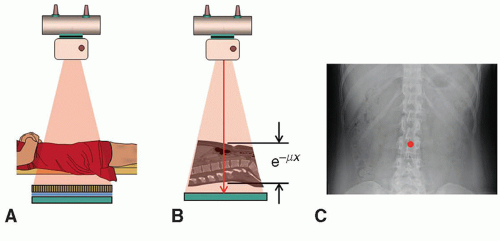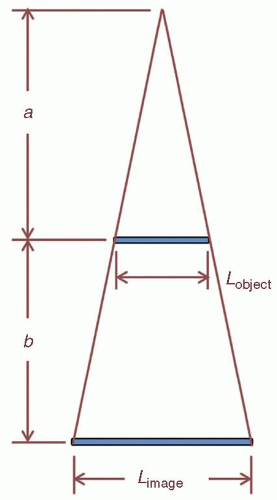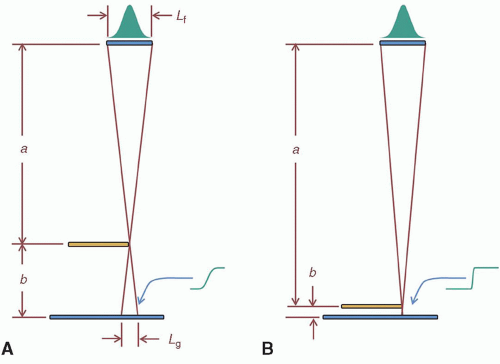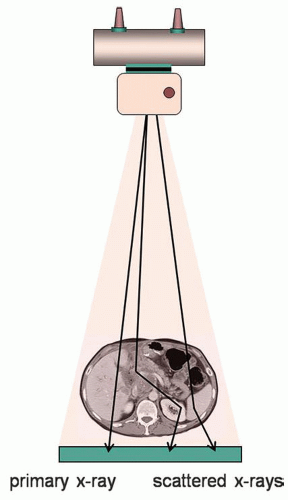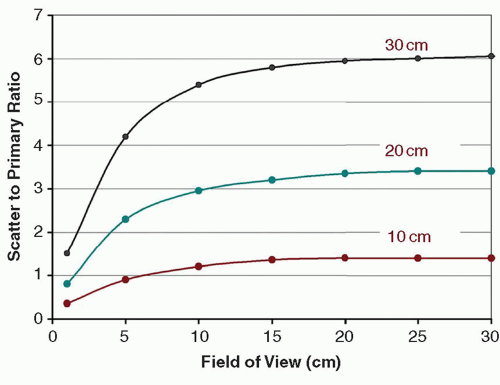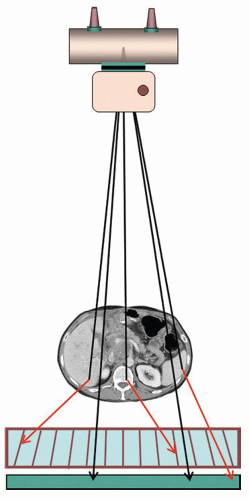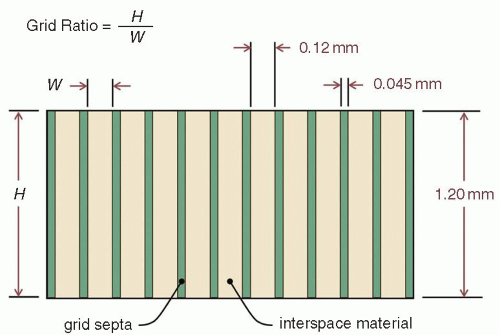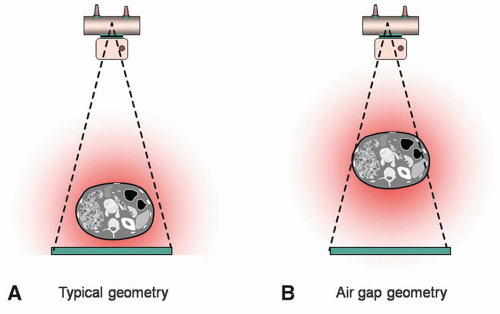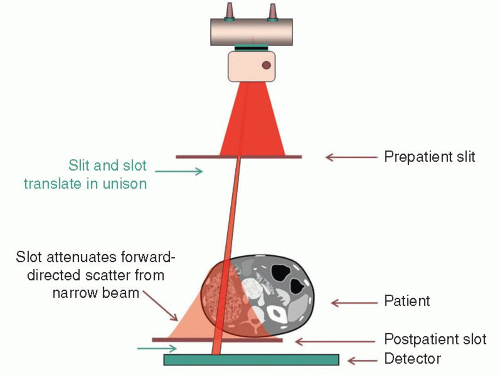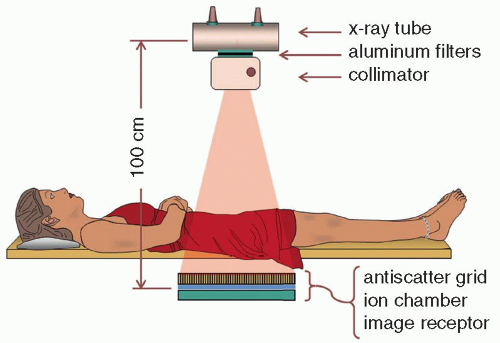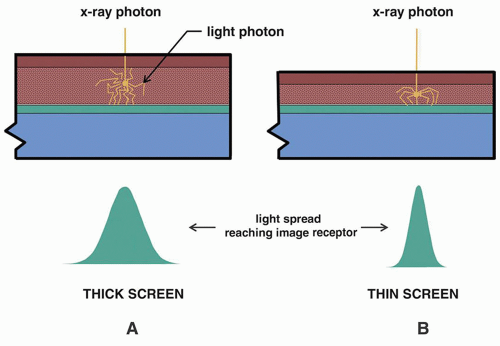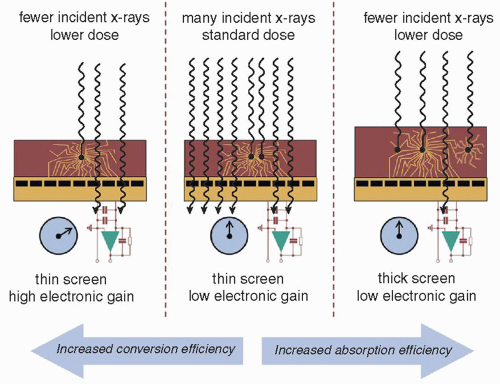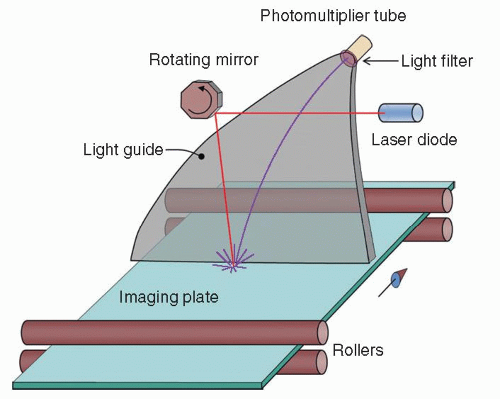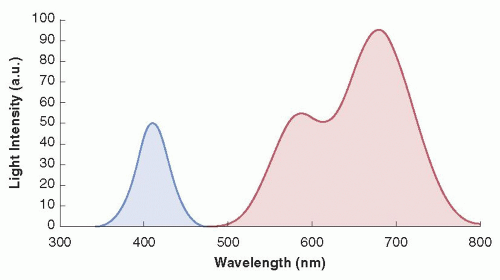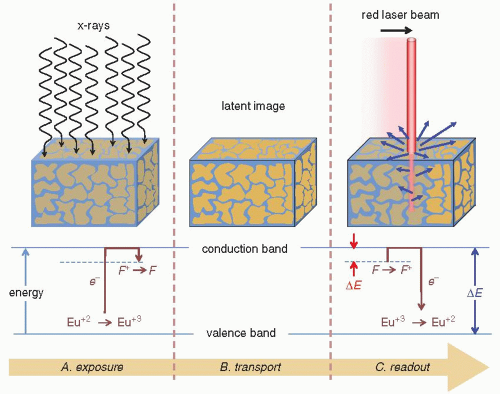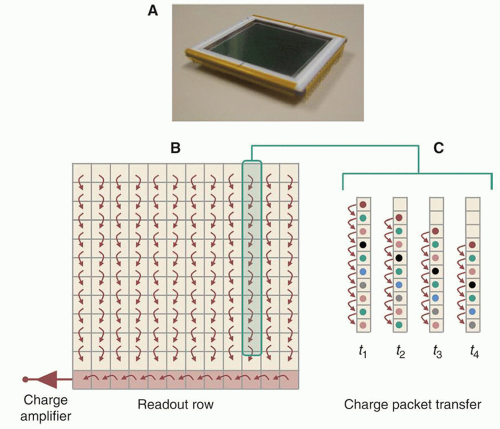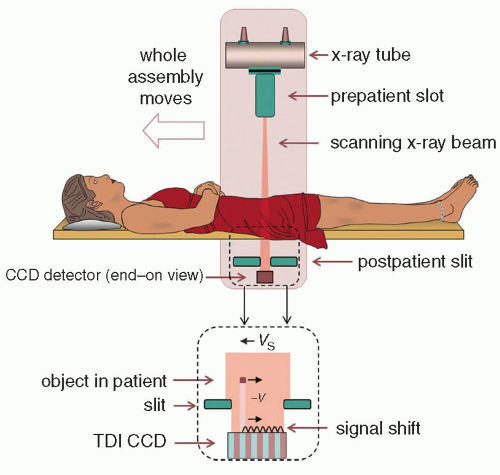Radiography
7.0 INTRODUCTION
This chapter explains how the technology described in Chapter 6 is used to project the shadows of a threedimensional object onto a two-dimensional detector to produce a clinical radiographic image (Fig. 7-1). Understanding the fundamentals of radiography is important because many of these principles also apply to other imaging modalities such as mammography, fluoroscopy, and computed tomography. The geometry of the examination, scattered radiation and methods of control, and selection of exposure technique settings are discussed including their effects on the resulting image. Methods for converting x-rays that exit the patient into a digital image are described in detail. Patient safety aspects include the need for derived quantities for feedback of appropriate exposure factor selection and the meaning of these exposure index values, as well as special considerations for pediatric digital radiography. Artifacts in digital radiographic images and their underlying causes are discussed because they may limit the clinical value of the examination or result in additional patient radiation exposure in the event of repeated imaging. Dual energy subtraction, a specialized method for isolating high-density and low-density features from radiographic projections, is explained.
7.1 GEOMETRY OF X-RAY PROJECTION
a. Magnification of features depend on distance from the image receptor, depth in the patient, and lateral distance from the central ray of the x-ray beam.
b. Geometric distortion of features is worse for large body parts and short source to image distance.
7.2 SCATTERED RADIATION IN PROJECTION RADIOGRAPHIC IMAGING
1. X-rays traveling through the patient may reach the image receptor unimpeded, or they may interact by one of two fundamental physical processes, the photoelectric effect or Compton scatter.
a. X-rays that reach the image receptor without interacting with the patient are called primary x-rays (P).
b. X-rays that interact via the photoelectric effect are removed from the primary beam.
c. X-rays that interact via Compton scatter are usually deflected from their path (Fig. 7-4).
d. Depending on trajectory, scatter may reach the image receptor (S).
2. Subject contrast is related to the ratio of primary x-rays reaching the image receptor versus those removed from the primary beam; thus, the effect of scatter is to degrade subject contrast.
3. In a digital image, contrast can be adjusted by digital image processing; however, scatter still acts to increase noise, degrading the signal-to-noise ratio (SNR).
4. The amount of scatter (S) in an image is given by the scatter-to-primary ratio (SPR) or scatter fraction (F).

a. SPR increases with the volume of tissue in the beam, which increases with the thickness of the anatomy in the field of view (FOV) and the dimensions of the FOV (Fig. 7-5).
b. Example: For a typical abdominal radiograph of thickness = 25 cm and FOV = 30 cm × 30 cm, SPR = 4.5 and F = 82%; thus, most of the captured image is useless information (noise).
5. Scatter rejection methods are required for large FOV images of thick body parts.
6. Antiscatter grids are used to selectively transmit primary radiation and prevent scattered radiation from reaching the detector (Fig. 7-6).
7. Perpendicular and lateral alignment of the grid with the central ray of the x-ray beam is critical for proper scatter removal; misalignment can cause artifacts in the image.
8. Characterization of grids by features of their construction (Fig. 7-7).
a. Grid types: linear, focused, crossed.
b. Grid ratio = interspace height versus interspace width with ratios of 8:1, 10:1 and 12:1 common; 6:1 and 14:1 less common.
c. Interspace material: aluminum (low cost) or carbon fiber (high transmission of primary).
d. Grid frequency = # grid septa/cm; in Figure 7-7, the frequency is 60 lines/cm; 70 to 80 lines/cm grids are available but are more expensive; typically used for digital receptors with high resolution.
e. Focal length = intended SID range—typical source-image distances are 100 and 183 cm; lower ratio grids have less crucial focusing range.
f. Grid cutoff occurs when the primary beam is attenuated and occurs with the wrong SID; other sources include laterally shifted or tilted grid (nonperpendicular) with respect to the central axis, or upside-down focused grid.
9. Grids can be stationary or moving.
a. A stationary grid produces regularly spaced image shadows (grid lines) that are routinely ignored by radiologists; high frequency fixed grids have unresolvable lines relative to the detector resolution, but low frequency aliasing patterns can result in image nonuniformity.
b. A Bucky grid moves perpendicular to the linear septa during the x-ray exposure to blur the grid lines.
10. The Bucky factor is the relative increase in x-ray output that must be used to compensate for using the grid.
a. Primary x-rays falling on septa and scattered x-rays are prevented from reaching the receptor.
b. For fixed speed receptors, the ratio of the mAs with grid versus without grid is the Bucky factor.
c. For variable speed digital receptors, lower signal with grid is adjusted by amplification.
d. Loss of primary radiation considers grid primary transmission factor for compensation.
e. The Bucky factor for variable speed receptor is typically less than for a fixed speed receptor.
11. Other metrics describing grid performance:
a. Primary transmission factor, Tp = the fraction of primary x-rays penetrating the grid
(ii) In digital radiography, 1/Tp is a reasonable replacement for the Bucky factor.
b. Scatter transmission factor, Ts = the fraction of scattered x-rays penetrating the grid—ideally this is 0, but typical values of Ts are between 0.05 and 0.20
12. Alternate scatter rejection methods: air gap technique, slot-scan technique, scatter processing
a. The air gap technique (Fig. 7-8) involves moving the patient away from the image receptor.
(i) X-rays scattered in the patient are less likely to reach the image receptor.
(ii) Introduces magnification, decreases the anatomy within the FOV, increases blur from the focal spot, and requires higher exposure technique with increased SID.
b. The slot-scan technique (Fig. 7-9) works by exposing only a small part of the anatomy at a time and translating across the FOV to create the composite image.
(i) The amount of scatter is reduced because of the narrow FOV of the slot.
(ii) The slot-scanner does not require a grid.
(iii) Dose efficiency depends on alignment of prepatient slit and postpatient slot.
(iv) Higher mAs and higher tube loading, with opportunity for patient motion.
c. Digital image processing for a physical antiscatter grid—“virtual grid.”
(i) Useful where grid alignment is difficult (e.g., bedside radiography) and cutoff likely.
(ii) Requires estimate of patient thickness, amount of scatter reaching detector.
(iii) Scatter is nonuniform and depends on collimation; anatomy is variable.
(iv) Noise and signal indistinguishable, and possibly compromising for low contrast signals.
(v) Uses lower kV and similar mAs as technique required for grid study.
7.3 TECHNIQUE FACTORS IN RADIOGRAPHY
1. Primary technique factors include tube voltage (kV), tube current (mA), exposure time (s), and source to image distance (SID); added filtration must also be considered (Fig. 7-10).
a. SID usually 100 cm, 183 cm for upright chest examination
b. kV adjusted for examination type
c. Product of tube current (mA) and time (s) as mAs to adjust fluence for kV, SID, and filtration
2. kV selection involves compromises based on fundamental interactions of x-rays.
a. Lower kV emphasizes contrast based on photoelectric effect (PE) for bone/barium contrast and appropriate for thin body parts.
b. Higher kV generally produces lower patient dose, is needed for thick body parts, is used to decrease rib contrast in chest examinations, and can reduce exposure time.
3. Current time product (mAs) controls x-ray fluence, where output fluence is linear with mAs.
a. High mA allows shorter exposure time for constant mAs, but requires large focal spot.
b. Deliberately long exposure times are selected to blur anatomic features (breathing techniques).
4. Technique chart (see textbook Table 7-1, pg. 237) specifies control settings for each radiographic view, including:
a. kV, mAs, focal spot selection (large/small), SID, filtration (if filter-selectable system), and grid
b. May include modifications for patient thickness
5. The protocol book defines views that comprise an examination, typically consisting of multiple views.
a. Anteroposterior (AP) or posteroanterior (PA), lateral (LAT), and unique positions such as oblique
6. Manual techniques require the technologist to set the kV and mAs, typically based on previous exposures.
a. Prevalent in pediatric radiology, bedside radiography and certain views
7. Automatic exposure control (AEC) regulates the radiation delivered to the image receptor.
a. Ion chamber(s) measure the radiation passing through the patient incident on the receptor.
b. Some digital image receptors can measure and integrate signal with time.
c. Circuits measure the transmitted radiation fluence and a proportional voltage signal is produced.
d. Signals are compared to a calibrated value, and when reached, the exposure is terminated.
e. Proper positioning of ion chambers or active areas on a flat-panel receptor are crucial.
f. Acquisition optimization includes patient size selection, appropriate kV, mA, SID, grid/no grid.
8. Ideal technique guide considers all aspects of the imaging chain, including generator output, beam quality, SID, collimation, patient thickness, grid attenuation, image receptor sensitivity, image processing, and patient dose commensurate with exam requirements in terms of SNR and CNR.
7.4 SCINTILLATORS AND INTENSIFYING SCREENS
1. Scintillators for converting x-rays to visible light (called indirect detectors) use amorphous and structured phosphors.
a. Amorphous scintillators are fine-grain phosphor powders held together by binder material.
(i) X-ray produced light spread is diffuse with mutiple scattting events.
(ii) Spatial resolution decreases with thickness; absorption efficiency increases with thickness, with a tradeoff of resolution versus dose efficiency (Fig. 7-11).
b. Strucured scintillators have a crystalline structure that act as light pipes.
(i) Internal reflection of light at crystal interfaces reduce light spread.
(ii) Resolution is preserved with thicker material that increases absorption efficiency.
(iii) CsI (cesium iodide) is a structured phosphor widely used in x-ray flat-panel receptors.
(iv) Structured phosphors are fragile, hygroscopic (absorb water and must be sealed), and expensive.
(v) Spatial resolution is better compared to an equal absorption efficient amorphous scintillator.
7.5 ABSORPTION EFFICIENCY AND CONVERSION EFFICIENCY
1. Absorption efficiency (AE) and conversion efficiency (CE) are important factors for indirect x-ray detectors.
2. Absorption efficiency depends on effective Z, density (ρ), thickness, and x-ray beam energy.
a. Quantum detection efficiency (QDE) describes how well detectors capture x-rays, but does not consider fluorescence, where energy is re-emitted from the detector.
b. Energy absorption efficiency is a better metric because most x-ray detectors are energy integrators, not photon counters.
3. Conversion efficiency describes how efficiently the optical signal is transferred from the scintillator to the photodetector through amplification and conversion into a digital signal.
a. Examples: X-ray-to-light conversion in scintillator, light-to-charge conversion in photodetector, light-gain in digital detectors, geometry and lens efficiency in optically coupled detectors
b. Directly relates to radiation dose needed to produce a given signal level
4. Absorption efficiency and conversion efficiency consequences on image quality (Fig. 7-12).
a. Conversion efficiency increase of G (gain) allows x-ray fluence reduction by G for same signal, which increases the relative quantum noise by [check mark]G, since 1/G photons are recorded.
b. Absorption efficiency increase of G allows x-ray fluence reduction by G for same signal, but the reduction of photons by 1/G is balanced by absorption efficiency of G, so quantum noise is unchanged.
5. Thicker, denser conversion layers increase absorption efficiency but also increase blurring and decrease spatial resolution; structured phosphors overcome resolution loss.
7.6 COMPUTED RADIOGRAPHY
1. Computed radiography (CR) = systems that use photostimulable phosphor (PSP) image receptors
a. PSP screens, typically comprised of barium fluorobromide (BaFBr), are passive receptors manufactured in sizes similar to screen-film receptors.
b. Incident x-rays generate fluorescence and elevate excited electrons into energy traps in the PSP.
c. The exposed imaging plate with latent image is processed by a CR reader with an optical stage, plate translation mechanics, scanning laser beam, optical light guide, and photomultiplier tube (Fig. 7-13).
d. Stored energy is released by laser light by photostimulated luminescence (PSL).
e. Laser excitation energy (red) is lower than stimulation luminescence (indigo); (Fig. 7-14).
f. Excitation models describe the production of PSL (Fig. 7-15).
2. Laser scanning of the IP does not release all of the trapped electrons.
a. The same IP can be scanned a second or third time with little loss of signal.
b. The IP must be exposed to bright white light to remove residual signal.
c. Without thorough erasure, a “ghost” image will appear on the next radiographic exposure.
3. CR technology enabled the all-digital radiology operation-in clinical practice for more than two decades.
a. Limited reimbursement, higher handling, and less DQE have disincentivized use of CR.
7.7 CHARGE-COUPLED DEVICE AND COMPLEMENTARY METAL-OXIDE SEMICONDUCTOR DEVICES
1. Charge-coupled device (CCD) detectors make images from visible light.
a. CCD chip is a Si integrated circuit with an array of discrete detector elements etched into its surface.
(i) Linear array—one or more rows; 1 × 2048 or 96 × 4096 dexels for a slot scanner
(ii) Area array—2.5 × 2.5 cm with 1024 × 1024 or 2048 × 2048 dexels
b. Si surface of CCD is photosensitive, liberating electrons linearly with light intensity.
c. Electrons remain in dexel because of voltage barrier on boundary.
d. Read-out of charge pattern occurs by shifting charges in parallel by voltage changes at the barrier.
e. For a 2D CCD array, the charges are shifted to the bottom row, with horizontal readout (Fig. 7-16).
f. The process is repeated one row at a time for complete readout of the array.
2. The small size of CCD detectors compared to the FOV required for radiography have led to a decline in use.
a. Inefficient optical coupling with demagnification leads to loss of light and large statistical uncertainly.
b. The quantum sink, the stage where the number of quanta is lowest in the imaging chain and statistics are worst, occurs in large FOV CCD systems (see text book Fig. 7-18A) with low DQE.
3. Linear CCD arrays coupled to a scintillator by tapered fiber-optic channels are used in slot-scan imagers
a. Major advantage is scatter rejection of the slot-scan; no antiscatter grid is required.
b. Readout by time delay and integration (TDI) yields high-dose efficiency and good SNR (Fig. 7-17).
c. Slot-scan devices and systems are clinically useful for chest and full body trauma examinations.
4. Complementary metal-oxide semiconductor (CMOS) light-sensitive arrays are alternative to CCD arrays.
a. CMOS arrays are random access memory “chips” with built-in photosensitive detectors, storage capacitors, and active readout electronics, operating at low voltage (3 to 5 volts).
b. Any dexel on the chip can be addressed in read or read-and-erase mode, useful for “built-in” AEC.
c. Large area CMOS detectors with up to 75 µm dexel size are being used (see Chapter 8—Mammography).
d. CMOS detectors are also used as a replacement for image intensifiers (see Chapter 9—Fluoroscopy).
7.8 FLAT PANEL THIN-FILM TRANSISTOR ARRAY DETECTORS
1. Technology most widely used for radiography in 2021 (and fluoroscopy—see Chapter 8).
Stay updated, free articles. Join our Telegram channel

Full access? Get Clinical Tree


